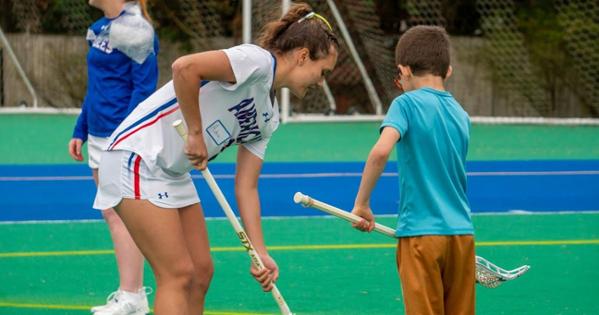Won’t You Be Our Neighbor?

This past Saturday was a win-win for the university’s youngest neighbors and women’s lacrosse team.
About 30 neighborhood children—some barely taller than the lacrosse sticks they wielded—joined AU’s student-athletes for a free skills clinic after the Eagles’ home match at Jacobs Recreation Complex. The playful afternoon of stretching, drills, and autographs exemplified the type of relationship the university is striving to foster between AU and the surrounding community.
“My daughter and her Horace Mann Elementary School classmates had such a great experience at the clinic, and we can’t thank the players and coaches enough for making it possible,” said William Clarkson, cochair of the AU Neighborhood Partnership’s (AUNP) facilities planning working group, whose children attended the clinic. “This is exactly the type of community engagement that AU should be focused on, including building partnerships with the neighborhood public schools.”
“What a joy to see AU athletes engage with our kids in this fun sport,” added Rita McWilliams, a Spring Valley resident and publisher of Stroll Spring Valley, who also attended the event. “[I’m] looking forward to many more enriching AU activities for all ages as the year continues.”
The AUNP formed in 2018 during the development of the 2021 Campus Plan to deepen AU’s connection with its neighbors. The formal body operates through five standing working groups—engagement and communications (on which McWilliams serves), facilities planning, student life and safety, transportation and parking, and data and metrics—each co-led by a neighborhood resident and a member of the university.
AUNP is also guided by a steering committee made up of community organizations and AU representatives, which is cochaired by Seth Grossman, vice president of administration and chief administrative officer, and neighbor Jerry Gallucci. The partnership makes decisions through consensus around shared priorities.
The partnership underscores AU’s commitment to being a part of—not apart from—Washington, as detailed in our Changemakers for a Changing World strategic plan. “We want to be—and President Burwell has really emphasized this—a good neighbor and a good member of the DC community,” Grossman said.
“We want to be—and President Burwell has really emphasized this—a good neighbor and a good member of the DC community,” Grossman said.
The AUNP complements the Community Liasson Committee (CLC), an advisory group comprised of community organizations and university representatives required by the DC Zoning Commission Order, according to the 2011 and 2021 campus plans. All universities in DC are required to develop a campus plan in consultation with the community, which is approved by the zoning commission.
The CLC is legally bound to meet quarterly to exchange information about university activities that may affect the surrounding community. These meetings provide an opportunity for the university and neighbors to update attendees on university priorities, discuss issues of concern and share relevant information. The next CLC quarterly meeting will be held June 3 at 6:30 p.m.
The AUNP takes that required work a step further.
“It makes it better if you can get people to talk to each other about what the problem is and try to come up with decisions and policies that are going to be a win-win for everybody,” said Don Edwards, the contracted facilitator for AUNP and the cofounder and board chair for Justice and Sustainability Associates.
A key success of the AU Neighborhood Partnership has been working together to solve parking and transportation issues that affect both campus and the surrounding areas.
Josh Finver, AU’s assistant director of transportation demand management, who cochairs AUNP’s transportation and parking working group, said resident input helps make “a better community for everybody.”
“The best way to make sure it continues to succeed is for people to participate,” Finver said. “That goes both ways from the AU and the neighborhood. We want to continue to have an open and productive dialogue.”
The next step for AUNP is developing more positive interactions between the university and its neighbors around mutual interests by inviting residents to lectures and events, sports clinics, and other campus resources.
On May 3 at 7 p.m., AU’s Office of Community and Government Relations will host a movie night featuring Trolls Band Together for children who attend nearby elementary schools. Targeted toward students at Horace Mann Elementary School, one of four DC public schools near campus, the event held in AU’s Woods-Brown Amphitheater is open to all.
“It’s not just about how we coexist, but how we can integrate together,” Grossman said. “The neighbors can also be beneficiaries of all AU has to offer.”
Want to know more? Learn about how to join the AU Neighborhood Partnership and submit questions, comments, and concerns here.
